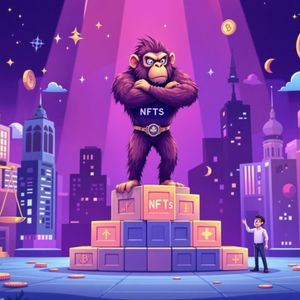NFT Trademark Protection: Crucial Legal Victory Reshapes Digital Asset Rights
9 min read
BitcoinWorld NFT Trademark Protection: Crucial Legal Victory Reshapes Digital Asset Rights The vibrant world of digital assets has just received a groundbreaking legal affirmation that promises to reshape its future. A recent ruling by the U.S. Court of Appeals for the Ninth Circuit has delivered a crucial victory for NFT trademark protection , firmly establishing Non-Fungible Tokens (NFTs) as “goods” under established trademark law. This isn’t merely a win for Yuga Labs, the creative force behind the iconic Bored Ape Yacht Club (BAYC); it’s a pivotal moment that underscores the growing maturity of the Web3 ecosystem and the increasing relevance of traditional intellectual property rights in decentralized spaces. A Landmark Decision: Defining NFTs as “Goods” for Trademark Protection At the core of this high-stakes legal battle lies the dispute between Yuga Labs and artist Ryder Ripps. Ripps had created and sold a collection of “lookalike” NFTs, dubbing them “expressive appropriation art” to critique the BAYC brand. While an earlier $9 million judgment against Ripps was vacated, the Ninth Circuit’s core declaration carries immense weight for NFT trademark protection and beyond: NFTs Classified as “Goods”: This is arguably the most significant aspect of the ruling. By categorizing NFTs as “goods” for trademark purposes, the court effectively extends the robust protections of the Lanham Act (the primary federal trademark statute in the U.S.) into the digital realm. This means that NFTs, despite their intangible nature, are now recognized in a way that allows for the same brand protection as physical products like shoes or electronics. Affirmation of Yuga Labs’ Rights: The court unequivocally upheld Yuga Labs’ right to trademark protection for its Bored Ape Yacht Club NFTs. This reinforces the idea that the distinct visual identity, branding, and goodwill associated with a successful NFT collection are legally defensible assets. Rejection of Artistic Defenses: Many of Ryder Ripps’ arguments, including claims of fair use and First Amendment protection for his “appropriation art,” were largely rejected. The court clarified that while artistic expression is valued, it cannot override established trademark rights when there’s a risk of consumer confusion. Return to Lower Court for “Consumer Confusion” Trial: The case will now proceed to a lower court to specifically determine whether Ripps’ lookalike collection actually caused “consumer confusion” among buyers. This element is central to proving trademark infringement. This decision provides much-needed clarity in a nascent and often ambiguous legal landscape surrounding digital collectibles. It acknowledges the commercial value, brand identity, and significant investment inherent in successful NFT projects, paving the way for greater legal certainty and stability. Navigating the Nuances of “Consumer Confusion” in NFT Trademark Cases The concept of “consumer confusion” is the cornerstone of trademark infringement claims. It refers to the likelihood that consumers would mistakenly believe that a product or service originates from, is sponsored by, or is affiliated with a different source. In the context of NFT trademark protection , this involves a multi-faceted inquiry: Direct Confusion: Did buyers of Ripps’ RR/BAYC NFTs genuinely believe they were purchasing official Yuga Labs products? Source Confusion: Would a reasonable person think that Ripps’ collection was produced, authorized, or endorsed by Yuga Labs? Initial Interest Confusion: Even if a consumer eventually realizes the product is not authentic, did the similar mark initially draw them in under a false pretense? The Ninth Circuit’s decision to send the case back for a factual determination on consumer confusion highlights that while trademark rights exist, their infringement still requires proof of actual or likely misleading of the public. This aspect of the trial will be crucial, as it delves into the perception and behavior of NFT market participants. It underscores that while artistic intent may be present, the commercial reality of a project’s presentation and potential to mislead consumers holds significant weight in the eyes of the law. Fair Use and First Amendment: Balancing Artistic Freedom with NFT Trademark Protection Ryder Ripps’ defense heavily leaned on the principles of fair use and the First Amendment, arguing that his work was a form of commentary and parody, thus protected speech. However, the court’s stance on these arguments is particularly instructive for the future of digital art and intellectual property: Fair Use Limitations: While fair use permits the use of copyrighted material for purposes such as criticism, commentary, news reporting, teaching, scholarship, or research, it is not an unlimited license. The court likely found that Ripps’ commercial sale of similar NFTs, which directly competed with Yuga Labs’ offerings and potentially confused consumers, exceeded the bounds of fair use. The transformative nature of a work is key in fair use analysis, but if the new work primarily serves to exploit the original’s market, it often fails this test. First Amendment Boundaries: The First Amendment protects freedom of speech, but this protection is not absolute, especially when it encroaches upon established commercial rights. The court’s ruling suggests that while Ripps has the right to express his views, he cannot do so in a manner that constitutes trademark infringement by creating consumer confusion regarding the source of goods. The balance here is between protecting artistic expression and preventing market deception. This outcome sets a significant precedent: even in the realm of “appropriation art” or commentary, artists operating within the commercial space of NFTs must respect existing trademarks. It clarifies that merely labeling something as “art” does not automatically grant immunity from trademark infringement claims, particularly when commercial gain and potential consumer deception are involved. The Far-Reaching Implications for Web3 Intellectual Property and NFT Trademark Protection This ruling is not an isolated event; it represents a foundational shift in how intellectual property is perceived and protected within the Web3 landscape. Its implications are vast and will resonate across various stakeholders: Stakeholder Group Key Implication of the Ruling Actionable Insights & Recommendations NFT Creators & Artists Strengthened ability to defend their brands against unauthorized replication and counterfeiting. Increased confidence in monetizing their unique digital creations. Proactively register trademarks for your NFT collections’ names, logos, and distinct visual elements. Clearly define the intellectual property rights granted to NFT holders (e.g., commercial use, personal use) in your terms and conditions. Monitor the market for infringing collections and be prepared to take legal action. NFT Collectors & Buyers Greater assurance of authenticity and reduced risk of purchasing fraudulent or confusingly similar knock-offs. Increased long-term value potential for legitimate, trademarked collections. Always verify the authenticity and official source of an NFT collection before purchasing. Research the creator’s reputation and their commitment to protecting their IP. Understand the underlying IP rights associated with the specific NFT you are acquiring. NFT Marketplaces & Platforms Clearer legal basis for implementing robust IP infringement reporting and removal policies. Increased responsibility to police listings and ensure compliance. Develop and enforce strict IP infringement policies, including clear takedown procedures. Invest in tools and processes to identify and remove infringing collections proactively. Educate users about IP rights and the consequences of infringement on their platforms. Legal & IP Professionals Establishes a critical precedent for future digital asset IP cases, providing a framework for navigating complex Web3 legal challenges. Develop specialized expertise in Web3 IP law, combining traditional IP principles with blockchain nuances. Advise clients on comprehensive proactive IP strategies, from registration to enforcement in the digital space. Stay abreast of evolving case law and technological advancements in the NFT sector. This decision underscores a crucial maturation of the legal framework surrounding digital assets. It sends a strong message that the “wild west” era of Web3 is evolving into a more structured, albeit still dynamic, landscape where established legal principles will increasingly apply. Challenges and Opportunities in Upholding NFT Trademark Protection While this ruling is a significant stride forward, the decentralized and global nature of NFTs still presents unique challenges for enforcing NFT trademark protection : Jurisdictional Complexities: NFTs transcend geographical borders. Enforcing a U.S. court ruling against an infringer operating in a different country can be a complex and resource-intensive endeavor. Anonymity and Decentralization: The pseudonymous nature of some blockchain interactions can make it difficult to identify and pursue infringers, especially if they operate across multiple decentralized platforms. Technological Enforcement: Integrating legal enforcement with blockchain’s immutable nature requires innovative solutions. While legal action can deter, physically “removing” an infringing NFT from a blockchain is generally impossible. However, these challenges also spur innovation and present new opportunities: On-Chain IP Solutions: The growing need for robust IP protection could accelerate the development of blockchain-based IP registration, tracking, and enforcement mechanisms, potentially using smart contracts for automated dispute resolution. Industry Standards: This ruling may catalyze the development of clearer industry standards and best practices for IP rights within the NFT ecosystem, leading to greater consistency and fewer disputes. Increased Investor Confidence: A more secure legal environment for IP will undoubtedly attract greater institutional investment and mainstream brand participation in the NFT space, fostering sustainable long-term growth and innovation. This ruling is a clear signal that the legal system is actively engaging with and adapting to technological advancements, offering a framework for growth while safeguarding creators’ rights. It represents a crucial step towards building a more trustworthy and legally sound digital economy. The Road Ahead: What’s Next for the Yuga Labs Case and Beyond? The case’s return to a lower court for a trial on consumer confusion means the full story isn’t yet written. The outcome of this specific trial will be significant: If Ripps’ collection is found to have caused substantial consumer confusion, it could result in significant damages awarded to Yuga Labs and potentially an injunction preventing further sales of the infringing NFTs. Conversely, if consumer confusion is not proven to the jury’s satisfaction, it might limit the financial implications for Ripps, even with the affirmation of Yuga Labs’ underlying trademark rights. Regardless of the trial’s final verdict on confusion, the Ninth Circuit’s foundational declaration that NFTs are “goods” under trademark law stands as a monumental precedent. This alone is a significant victory for the digital asset space, providing a crucial legal bedrock for NFT trademark protection . This legal clarity empowers creators and protects consumers, fostering a more secure and reputable environment for digital innovation. It underscores the increasing importance of intellectual property in the rapidly evolving Web3 ecosystem, reminding us that even in decentralized worlds, established laws have a vital role to play in ensuring fairness, preventing deception, and promoting responsible growth. The journey of Web3 is one of constant evolution, and landmark legal precedents like this one are vital signposts along the way. They help shape a future where creativity is rewarded, and innovation can thrive within a robust framework of clear rights and responsibilities, ensuring that the digital frontier isn’t just exciting, but also secure and equitable. Frequently Asked Questions (FAQs) About NFT Trademark Protection Q1: What does it mean for NFTs to be considered “goods” under trademark law? A1: This means NFTs are treated similarly to physical products when it comes to trademark infringement. Creators can now seek legal protection for their NFT brands, names, and logos, just like companies protect their physical products, against unauthorized use that could confuse consumers. Q2: How does this ruling affect NFT creators? A2: It provides NFT creators with stronger legal tools to protect their intellectual property. They can now more effectively pursue legal action against copycat projects, counterfeit NFTs, and unauthorized derivatives that infringe on their brand’s trademark. Q3: What is “consumer confusion” in the context of NFT trademarks? A3: Consumer confusion refers to whether an average buyer would likely be misled into believing that an infringing NFT collection is affiliated with, sponsored by, or originates from the legitimate trademark holder (e.g., Yuga Labs). This is a key element that must be proven for a trademark infringement claim to succeed. Q4: Does this ruling limit artistic freedom or “appropriation art” in the NFT space? A4: The ruling clarifies that while artistic expression is valued, it does not grant absolute immunity from trademark law, especially when commercial gain and potential consumer confusion are involved. Artists must ensure their works do not mislead consumers about the source or affiliation of their digital goods. Q5: What should NFT buyers do to protect themselves after this ruling? A5: Buyers should always verify the authenticity of NFT collections, research the creator’s reputation, and understand the IP rights associated with their purchase. This ruling helps, but due diligence remains crucial to avoid counterfeit or infringing NFTs. Q6: What’s next for the Yuga Labs vs. Ryder Ripps case? A6: The case will return to a lower court for a trial specifically focused on whether Ryder Ripps’ lookalike NFTs caused actual “consumer confusion.” The outcome of this trial will determine potential damages and further legal remedies. If you found this article insightful, please consider sharing it with your network! Your support helps us continue to provide crucial updates and analysis on the evolving world of cryptocurrencies and digital assets. Share on X (formerly Twitter), Facebook, or LinkedIn! To learn more about the latest crypto market trends, explore our article on key developments shaping the future of digital asset ownership. This post NFT Trademark Protection: Crucial Legal Victory Reshapes Digital Asset Rights first appeared on BitcoinWorld and is written by Editorial Team

Source: Bitcoin World



